Intro to the Kibbe Body Type System: THE CLASSIC FAMILY: Soft Classics & Dramatic Classics
Welcome to the Kibbe for Beginners Series
This article is part of my Kibbe for Beginners series, where I explore the nuances of each body type family with clarity, depth, and real-life examples. The goal is to help you see and understand your natural silhouette, recognize your Yin-Yang balance, and discover how your shapes, proportions, and energy can guide styling decisions.
In this post, we’ll focus on the Classic family, diving into Soft Classics and Dramatic Classics. You’ll get detailed breakdowns of bone structure, flesh, and scaling, along with celebrity examples, styling guidance, and what to avoid, so you can observe how these types naturally express themselves in everyday dressing.
Understanding the Classic Family
The Classic family is defined by moderation across all aspects — size, frame, and flesh — blending Yin and Yang harmoniously. This balance creates a refined, symmetrical silhouette, distinct from the more extreme Romantics and Dramatics.
Kibbe Soft Classic Body Type
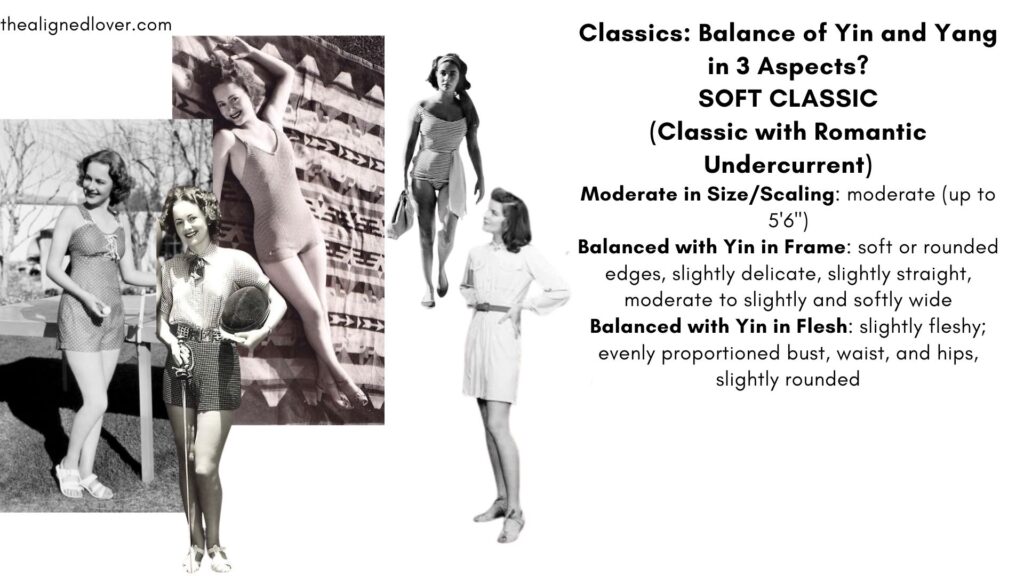
The Soft Classic is moderate in size and scaling. Relative to the Romantic, the SC looks taller, more elongated, broader, and more vertically compact. The bones of the Soft Classic are relatively more angular and straighter, but retain a bit of roundness throughout the edges and a little bit of gentle width. In terms of flesh, the Soft Classic is slightly Yin; softness can be observed especially at the upper limbs and there is a soft evenness of proportion throughout the chest, waist, and hips.
Kibbe Soft Classic Body Type: Size, Frame, and Flesh
- Comparison to Romantic: Taller, more elongated, broader, and more vertically compact.
- Bone structure: Relatively more angular and straighter than a Romantic, but retains a bit of roundness throughout the edges and gentle width.
- Flesh: Slightly Yin; softness especially at upper limbs, with soft evenness throughout chest, waist, and hips.
Summary / Key Takeaways:
- Soft Classics are moderate in all dimensions, blending subtle angularity with gentle softness.
- The Romantic comparison highlights the increased verticality, elongation, and slightly stronger bone structure.
- Yin traits appear in flesh and soft curves, but overall the silhouette remains balanced and harmonious.
The Dramatic Classic Body Type
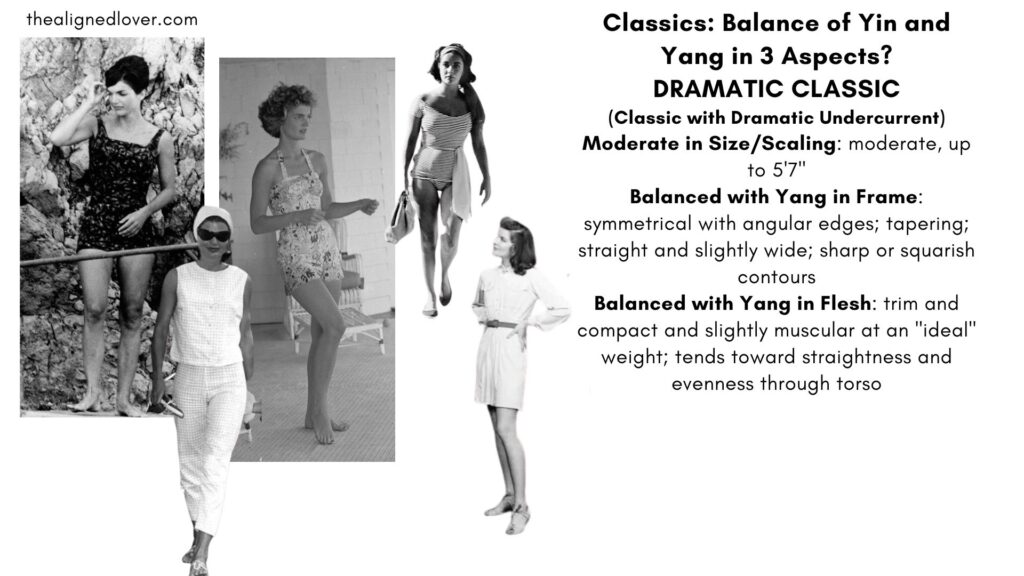
The Dramatic Classic definitely leans more Yang than their Yin counterparts. Like the Dramatics, the DC possesses more elongation, broadness, and angularity. Still, the Dramatic Classic frame is relatively more gently wide or square than the Dramatics, with much more symmetry and moderation. The Dramatic Classic leans more Yang in flesh- they tend to be trim and slightly muscular at lower weights and their torso tends towards a bit more of a streamlined or straight shape.
Kibbe Dramatic Classic Body Type: Size, Frame, and Flesh
- Yang Orientation: Definitely leans more Yang than Yin counterparts.
- Comparison to Dramatics: Shares elongation, broadness, and angularity, but frame is more gently wide or square, with more symmetry and moderation.
- Flesh: More Yang; trim and slightly muscular at lower weights, with a torso that trends toward a streamlined or straight shape.
Soft Classics vs Dramatic Classic Silhouettes
- Dramatic Classics combine Yang elongation and angularity with moderated symmetry, distinguishing them from full Dramatics.
- The silhouette is leaner and more sculpted than Soft Classics, yet balanced and harmonious.
- Trim, slightly muscular flesh and a streamlined torso define the overall shape.
Soft Classics vs Dramatic Classics
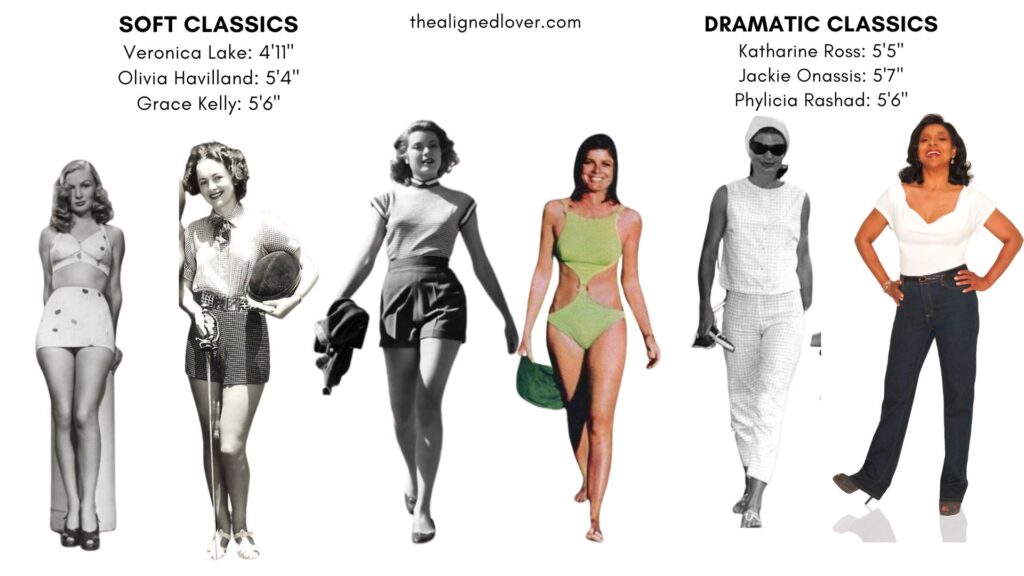
Soft Classics have more gentle roundness to their edges and take on a more soft width and fleshiness. Oppositely, Dramatic Classics have more angular edges and broadness with more of a streamlined width and leanness/litheness. Still, these classics exist on a spectrum and the degree of one’s undercurrent needs to be assessed with uniqueness in mind.
- Soft Classic: Gentle roundness at edges, softer width, and fleshiness.
- Dramatic Classic: More angular edges, broader shoulders, streamlined width, leaner/lither flesh.
- Spectrum: Both types exist on a continuum; individual Yin/Yang undercurrents should be assessed uniquely.
Soft Classics vs Dramatic Classic Styling
- Soft Classics emphasize subtle curves and soft width.
- Dramatic Classics emphasize angularity, lean lines, and broadness.
- Each Classic’s silhouette is unique; understanding the degree of Yin/Yang helps tailor insights to the individual.
How to Accommodate the Soft Classic and Dramatic Classic
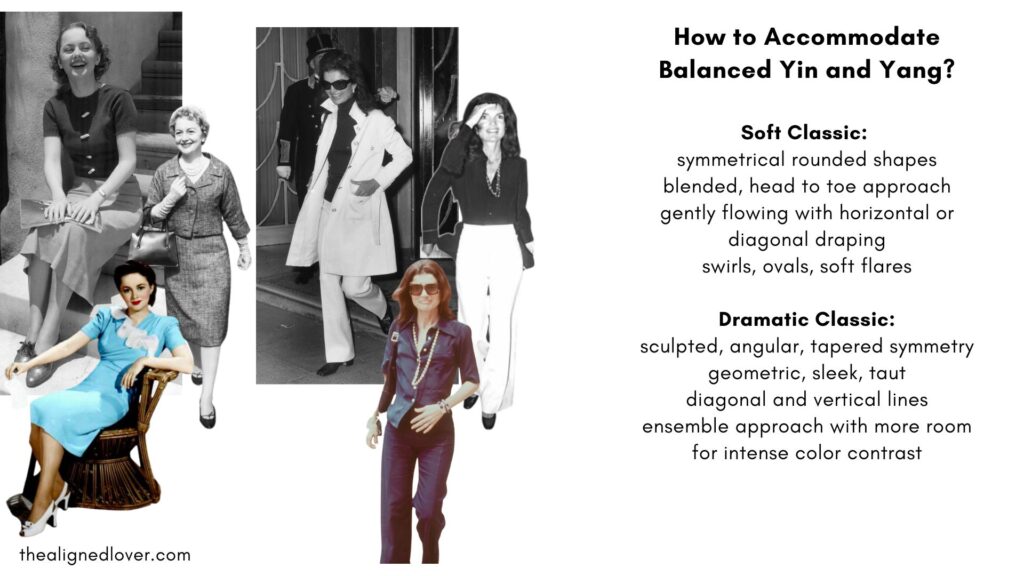
Soft Classics look best in a well blended and continuous head to toe ensemble. Their lines are softly symmetrical and gently rounded or flared, with restrained fluidity, horizontal and diagonal draping, and elegant shaping often prioritizes ovals, flares, soft pleated, and gentle ruching or swirling.
How to Accommodate Soft Classics
- Head-to-toe ensembles: Well-blended and continuous looks.
- Lines & Silhouette: Softly symmetrical, gently rounded or flared.
- Draping & Flow: Restrained fluidity with horizontal and diagonal draping.
- Shaping Details: Ovals, soft flares, pleats, gentle ruching, or swirling.
Soft Classic Styling Notes:
- Soft Classics shine in looks that maintain soft symmetry and subtle continuity.
- Gentle, flowing shapes enhance their natural Yin softness.
- Avoid breaking the line with harsh contrasts or jagged details.
Dramatic Classics look best in a head to toe approach that gives more freedom to play with intense color combinations so long as the result in rich and vibrant as opposed to disparate. They look best with sculpted, angular, and tapered lines, geometric symmetry, and a sleek and taut overall fit. As they are Yang in undercurrent, an extra dose of vertical or diagonal draping is excellent.
Dramatic Classic Accomodation
- Head-to-toe ensembles: Rich, cohesive looks that allow for bold color combinations.
- Lines & Silhouette: Sculpted, angular, and tapered lines with geometric symmetry.
- Fit: Sleek and taut overall fit, emphasizing elongation.
- Draping & Flow: Extra vertical or diagonal draping enhances the Yang undercurrent.
Dramatic Classic Styling Notes:
- Celebrates elongation, angularity, and boldness.
- Cohesive, rich color combinations complement the strong Yang silhouette.
- Avoid loose, overly soft, or rounded shapes that diminish the streamlined effect.
Soft Classics and Dramatic Classics: What to Avoid
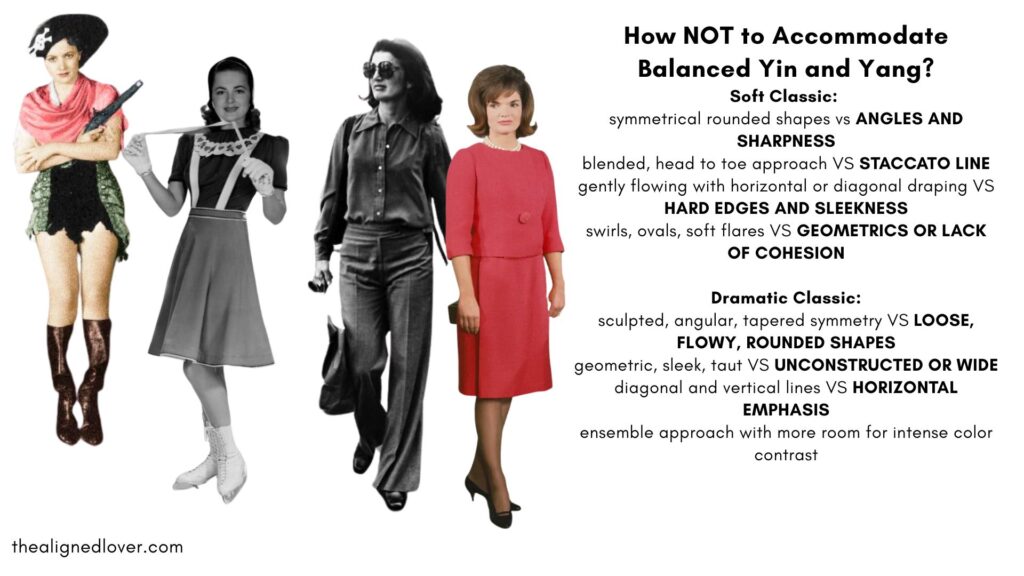
Soft Classics would do best to avoid overly broken and contrasting outfits that obscure their gentle continuity. Rugged, jagged, angular, geometric, and overly intricate details and lines do not play to their strengths.
Soft Classic: What to Avoid
- Overly broken or contrasting outfits that disrupt the continuous flow.
- Rugged, jagged, or angular shapes.
- Geometric or overly intricate details and lines.
Soft Classic Styling Warnings:
- Outfits that interrupt the gentle continuity reduce the harmony of the silhouette.
- Stick to smooth, flowing lines and subtle details to highlight natural softness.
Dramatic Classics obscure the beauty of their sleek silhouette when they dress in oversized, flowy, and unconstructed garments. Overly rounded and loose shapes with horizontal emphasis are also contrary to their natural figure.
Dramatic Classic: What to Avoid
- Oversized, flowy, or unconstructed garments that hide sleek lines.
- Overly rounded or loose shapes with horizontal emphasis.
- Styles that reduce the streamlined, angular, and taut silhouette.
Dramatic Classic Styling Warnings:
- Avoid clothing that diminishes the natural Yang elongation and sculpted shape.
- Stick to structured, tapered, and geometrically balanced designs to enhance the figure.
Modern Soft Classic and Dramatic Classic Examples
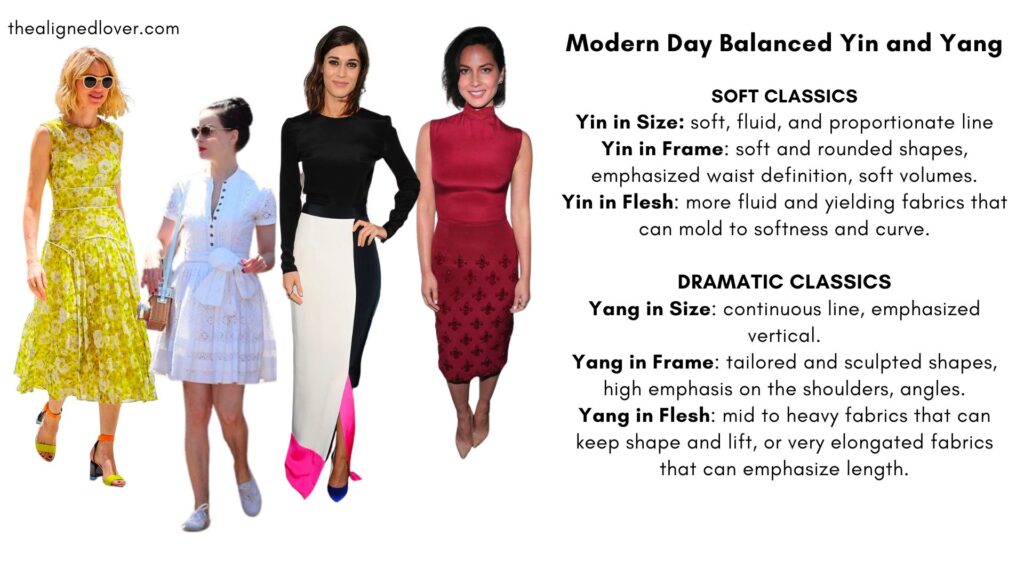
Soft Classic Examples:
- Naomi Watts and Dita von Teese exemplify beautiful soft symmetry and a subtle Romantic undercurrent.
- Shine in elegantly fluid, rounded lines.
- Key details: Symmetry, round necklines, soft waist and shoulder definition, and a restrained sense of flow or flare.
Dramatic Classic Examples:
- Lizzie Caplan and Olivia Munn excel when following Dramatic Classic styling principles.
- Shine in sleek, taut garments with a rich head-to-toe approach.
- Key details: Diagonal or vertical emphasis and sculpted linearity for a chic, dignified silhouette.
Modern Soft Classic and Dramatic Classic Styles to Avoid
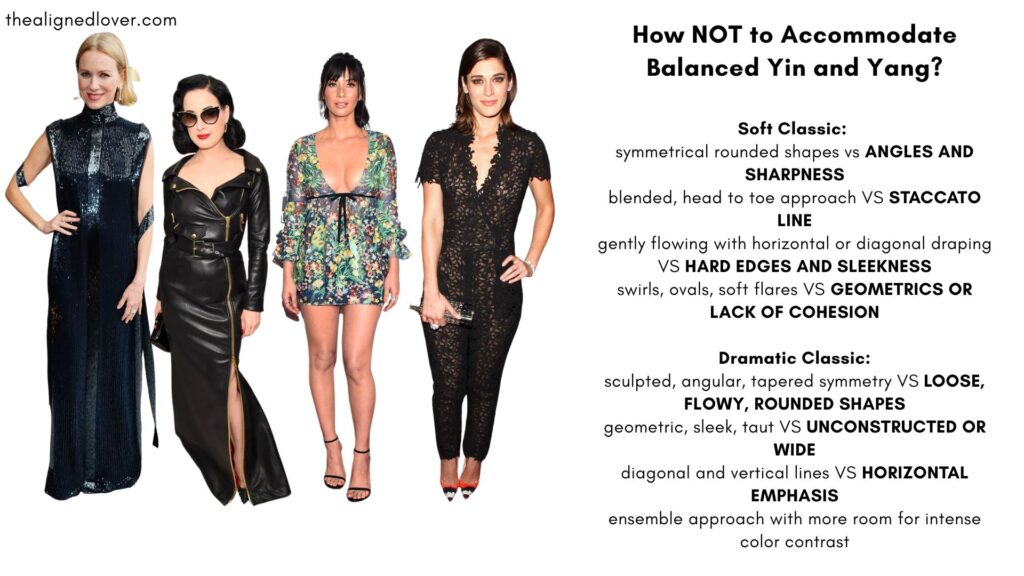
Soft Classics can drown in heavy fabrics with too much vertical emphasis/elongation and not enough fluidity softness.
Oppositely, Dramatic Classics can become overwhelmed with too much intricate shaping, cropped shapes, delicate or ornate details, and not enough sleek structure.
Styles to Avoid for Soft Classic and Dramatic Classic
Soft Classic:
- Heavy fabrics with excessive vertical emphasis or elongation.
- Lack of fluidity or softness, which obscures the gentle continuity.
Dramatic Classic:
- Excessive intricate shaping, cropped shapes, or overly delicate/ornate details.
- Lack of sleek structure, which diminishes the natural streamlined silhouette.
Styling Warnings:
- Soft Classics thrive in flowing, harmonious fabrics that preserve subtle curves.
- Dramatic Classics shine in sculpted, taut, and geometrically balanced designs.
FAQ: Soft Classic & Dramatic Classic
Q1: How do I know if I’m a Soft Classic or Dramatic Classic?
- Compare your bone structure, flesh, and silhouette to the descriptions above.
- Soft Classics: gentle roundness, moderate scaling, subtle Yin softness.
- Dramatic Classics: angular edges, leaner flesh, Yang elongation, and sculpted lines.
- Every individual exists on a spectrum, so your undercurrent may lean slightly toward one style.
Q2: Can Soft Classics wear patterns or details?
- Yes, but they should maintain flow and continuity. Smooth transitions, soft symmetry, and cohesive patterns enhance their natural elegance.
- Avoid overly broken or jagged designs that disrupt the silhouette.
Q3: Can Dramatic Classics wear soft or flowing fabrics?
- Yes, in moderation. Fabrics should maintain structure and enhance elongation rather than obscure sharpness.
- Prioritize sculpted, tapered garments and vertical/diagonal emphasis to complement the Yang undercurrent.
Q4: Are there modern celebrities I can reference for each type?
- Soft Classic: Naomi Watts, Dita von Teese
- Dramatic Classic: Lizzie Caplan, Olivia Munn
Q5: How can your personalized styling service help me?
- My highly detailed, bespoke styling service (Style & Silhouette) analyzes your unique silhouette, proportions, and Yin/Yang balance.
- You’ll receive tailored guidance to highlight your natural strengths, choose flattering shapes, and create cohesive outfits aligned with your body type.
- This service is deeply personal and ensures your wardrobe feels aligned, effortless, and intentional.
xx
Nona
